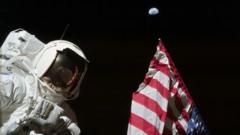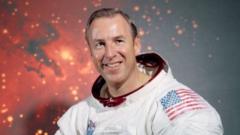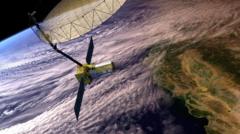After the passing of Jim Lovell, only five Apollo astronauts remain, each with a unique tale that exemplifies the pioneering spirit of human space travel, now reignited by NASA's Artemis program and global efforts.
**The Legacy of Apollo: The Final Moonwalkers and Future Lunar Aspirations**

**The Legacy of Apollo: The Final Moonwalkers and Future Lunar Aspirations**
As the world looks to the future of lunar exploration, the last surviving Apollo astronauts share their extraordinary stories and witness the new wave of missions from NASA and other nations.
In the shadow of the historic Apollo missions of the 1960s and 70s, NASA faces a new era of lunar exploration striving to send humans back to the Moon. The recent loss of Apollo 13 commander Jim Lovell has left only five surviving astronauts from that monumental mission, highlighting a trend whereby the once-thriving generation of astronauts is gradually diminishing.
Amid this change, NASA's Artemis program aims to establish a temporary human presence on the lunar surface within this decade. To further this mission, China has plans in place to land astronauts on the Moon by 2030, an endeavor underscored by its successful probe landing on the Moon's far side in 2024.
As private aerospace companies such as SpaceX and Boeing work towards sending their craft to the Moon, setbacks have marred their progress. NASA's Artemis 2, the first crewed lunar mission since Apollo 17, originally slated for launch last year, has been postponed to 2026, a reflection of the complexities involved in such ambitious undertakings.
The famed Apollo 8 mission, which set the stage for the future of lunar exploration, was partially executed by Jim Lovell alongside Frank Borman and Bill Anders – an historic feat wherein they tested the Command/Service Module while orbiting the Moon. Lovell’s ambitions to become the fifth human to walk on the Moon crumbled with the ill-fated Apollo 13 mission, slower in execution yet rich in drama, a story encapsulated in cinematic retellings.
Among the five remaining Moonwalkers, Buzz Aldrin stands eminent as the second human to walk on the lunar surface during the Apollo 11 mission. His poignant recollections of the Moon’s stark beauty and his continuous advocacy for space exploration, particularly Mars, keep alive the spirit of adventure that characterized the Apollo missions. His rich legacy persists as a source of inspiration for successive generations, a legacy symbolized in the character of Buzz Lightyear in the Toy Story films.
Charles Duke, who made history as the youngest person to walk on the Moon during Apollo 16 at age 36, has recounted the emotional landscape of his experience in space and his eagerness for future missions. He conveyed concerns regarding the challenges faced by upcoming astronauts in maneuvering through the severe terrain near the lunar south pole.
Fred Haise, an Apollo 13 astronaut whose mission faced perilous circumstances, pursued further government roles within aerospace after the program but never landed on the lunar surface due to budgetary complications.
Meanwhile, Harrison Schmitt, the first scientist to walk on the Moon during Apollo 17, shifted into a career in academia and politics after his NASA tenure, while David Scott, who commanded Apollo 15, became a pioneer in lunar transportation as one of the first astronauts to drive on the Moon.
Amidst ongoing attempts to reignite the spirit of space exploration, the stories of these five Moonwalkers remind us of the pioneering human spirit essential to navigate the complexities of future missions to the Moon and beyond. The exploration efforts, both by NASA and private sectors, suggest that a new generation of adventurers may soon add their chapters to the inspirational narratives begun by Apollo.
Amid this change, NASA's Artemis program aims to establish a temporary human presence on the lunar surface within this decade. To further this mission, China has plans in place to land astronauts on the Moon by 2030, an endeavor underscored by its successful probe landing on the Moon's far side in 2024.
As private aerospace companies such as SpaceX and Boeing work towards sending their craft to the Moon, setbacks have marred their progress. NASA's Artemis 2, the first crewed lunar mission since Apollo 17, originally slated for launch last year, has been postponed to 2026, a reflection of the complexities involved in such ambitious undertakings.
The famed Apollo 8 mission, which set the stage for the future of lunar exploration, was partially executed by Jim Lovell alongside Frank Borman and Bill Anders – an historic feat wherein they tested the Command/Service Module while orbiting the Moon. Lovell’s ambitions to become the fifth human to walk on the Moon crumbled with the ill-fated Apollo 13 mission, slower in execution yet rich in drama, a story encapsulated in cinematic retellings.
Among the five remaining Moonwalkers, Buzz Aldrin stands eminent as the second human to walk on the lunar surface during the Apollo 11 mission. His poignant recollections of the Moon’s stark beauty and his continuous advocacy for space exploration, particularly Mars, keep alive the spirit of adventure that characterized the Apollo missions. His rich legacy persists as a source of inspiration for successive generations, a legacy symbolized in the character of Buzz Lightyear in the Toy Story films.
Charles Duke, who made history as the youngest person to walk on the Moon during Apollo 16 at age 36, has recounted the emotional landscape of his experience in space and his eagerness for future missions. He conveyed concerns regarding the challenges faced by upcoming astronauts in maneuvering through the severe terrain near the lunar south pole.
Fred Haise, an Apollo 13 astronaut whose mission faced perilous circumstances, pursued further government roles within aerospace after the program but never landed on the lunar surface due to budgetary complications.
Meanwhile, Harrison Schmitt, the first scientist to walk on the Moon during Apollo 17, shifted into a career in academia and politics after his NASA tenure, while David Scott, who commanded Apollo 15, became a pioneer in lunar transportation as one of the first astronauts to drive on the Moon.
Amidst ongoing attempts to reignite the spirit of space exploration, the stories of these five Moonwalkers remind us of the pioneering human spirit essential to navigate the complexities of future missions to the Moon and beyond. The exploration efforts, both by NASA and private sectors, suggest that a new generation of adventurers may soon add their chapters to the inspirational narratives begun by Apollo.



















